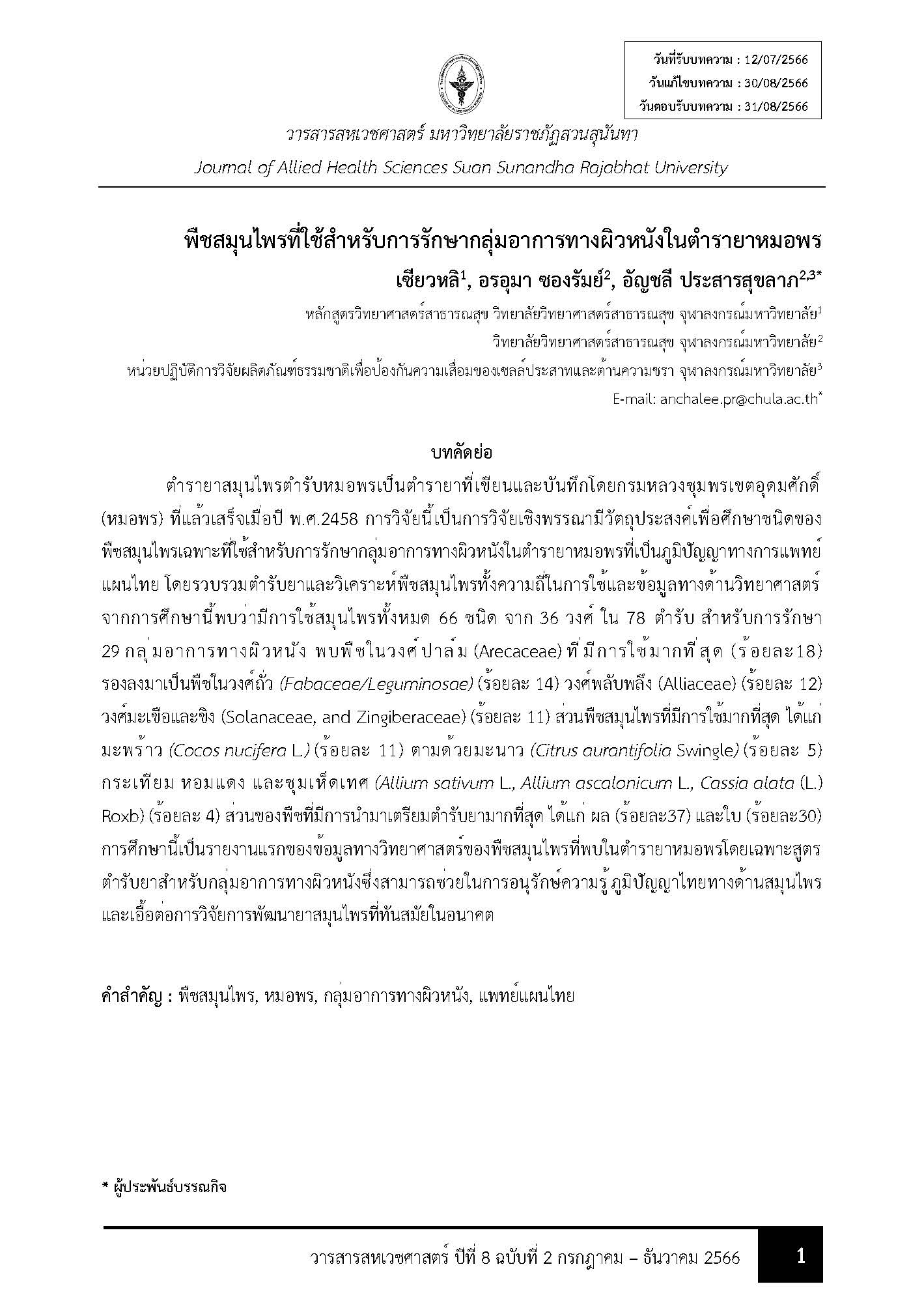พืชสมุนไพรที่ใช้สำหรับการรักษากลุ่มอาการทางผิวหนังในตำรายาหมอพร
Main Article Content
บทคัดย่อ
ตำรายาสมุนไพรตำรับหมอพรเป็นตำรายาที่เขียนและบันทึกโดยกรมหลวงชุมพรเขตอุดมศักดิ์ (หมอพร) ที่แล้วเสร็จเมื่อปี พ.ศ.2458 การวิจัยนี้เป็นการวิจัยเชิงพรรณามีวัตถุประสงค์เพื่อศึกษาชนิดของพืชสมุนไพรเฉพาะที่ใช้สำหรับการรักษากลุ่มอาการทางผิวหนังในตำรายาหมอพรที่เป็นภูมิปัญญาทางการแพทย์
แผนไทย โดยรวบรวมตำรับยาและวิเคราะห์พืชสมุนไพรทั้งความถี่ในการใช้และข้อมูลทางด้านวิทยาศาสตร์ จากการศึกษานี้พบว่ามีการใช้สมุนไพรทั้งหมด 66 ชนิด จาก 36 วงศ์ ใน 78 ตำรับ สำหรับการรักษา 29 กลุ่มอาการทางผิวหนัง พบพืชในวงศ์ปาล์ม (Arecaceae) ที่มีการใช้มากที่สุด (ร้อยละ18) รองลงมาเป็นพืชในวงศ์ถั่ว (Fabaceae/Leguminosae) (ร้อยละ 14) วงศ์พลับพลึง (Alliaceae) (ร้อยละ 12) วงศ์มะเขือและขิง (Solanaceae, and Zingiberaceae) (ร้อยละ 11) ส่วนพืชสมุนไพรที่มีการใช้มากที่สุด ได้แก่ มะพร้าว (Cocos nucifera L.) (ร้อยละ 11) ตามด้วยมะนาว (Citrus aurantifolia Swingle) (ร้อยละ 5) กระเทียม หอมแดง และชุมเห็ดเทศ (Allium sativum L., Allium ascalonicum L., Cassia alata (L.) Roxb) (ร้อยละ 4) ส่วนของพืชที่มีการนำมาเตรียมตำรับยามากที่สุด ได้แก่ ผล (ร้อยละ37) และใบ (ร้อยละ30) การศึกษานี้เป็นรายงานแรกของข้อมูลทางวิทยาศาสตร์ของพืชสมุนไพรที่พบในตำรายาหมอพรโดยเฉพาะสูตร
ตำรับยาสำหรับกลุ่มอาการทางผิวหนังซึ่งสามารถช่วยในการอนุรักษ์ความรู้ภูมิปัญญาไทยทางด้านสมุนไพรและเอื้อต่อการวิจัยการพัฒนายาสมุนไพรที่ทันสมัยในอนาคต
Article Details
เอกสารอ้างอิง
Khan MSA, Ahmad I. Herbal medicine: current trends and future prospects. New look to phytomedicine: Elsevier; 2019. p. 3-13.
Kennedy DA, Lupattelli A, Koren G, Nordeng H. Herbal medicine use in pregnancy: results of a multinational study. BMC Complement Altern Med. 2013; 13(1): 355. doi: 10.1186/1472-6882-13-355
Bahekar S, Kale R. Herbal plants used for the treatment of malaria-a literature review. Journal of pharmacognosy and Phytochemistry. 2013; 1(6): 141-6
Glover DD, Amonkar M, Rybeck BF, Tracy TS. Prescription, over-the-counter, and herbal medicine use in a rural, obstetric population. Am J Obstet Gynecol. 2003; 188(4):1039-45.doi: 10.1067/mob.2003.223
Sen S, Chakraborty R. Revival, modernization and integration of Indian traditional herbal medicine in clinical practice: Importance, challenges and future. J Tradit Complement Med. 2017; 7(2): 234-44. doi: 10.1016/j.jtcme. 2016.05.006
Dev S. Ancient-modern concordance in Ayurvedic plants: some examples. Environmental health perspectives. 1999; 107(10): 783-9
Afolayan AJ, Grierson DS, Mbeng WO. Ethnobotanical survey of medicinal plants used in the management of skin disorders among the Xhosa communities of the Amathole District, Eastern Cape, South Africa. Journal of ethnopharmacology. 2014; 153(1): 220-32
Development of moh phon’s diseases and herbal drugs database. 2021
J Mulholland, Thai traditional medicine: ancient thought and practice in a Thai context. 1979
Okoli R, Aigbe O, Ohaju-Obodo J, Mensah J. Medicinal herbs used for managing some common ailments among Esan people of Edo State, Nigeria. Pakistan Journal of Nutrition. 2007; 6(5): 490-6
Sharma HK, Chhangte L, Dolui AK. Traditional medicinal plants in Mizoram, India. Fitoterapia. 2001; 72(2): 146-61. doi: 10.1016/s0367-326x(00)00278-1
Jain R, Jain SK. Traditional medicinal plants as anticancer agents from Chhattishgarh, India: An overview. International Journal of Phytomedicine. 2010; 2(3):1
Purwanti E, Mahmudati N, Faradila S F, et al. Utilization of plants as traditional medicine for various diseases: Ethnobotany study in Sumenep, Indonesia[C]//AIP Conference Proceedings. AIP Publishing, 2020, 2231(1).
Van der Merwe D, Swan G E, Botha C J. Use of ethnoveterinary medicinal plants in cattle by Setswana-speaking people in the Madikwe area of the North West Province of South Africa[J]. Journal of the South African Veterinary Association, 2001, 72(4): 189-196.
Asase A, Kadera ML. Herbal medicines for child healthcare from Ghana. Journal of Herbal Medicine. 2014; 4(1): 24-36
Pham T L B, Thi T T, Nguyen H T T, et al. Anti-aging effects of a serum based on coconut oil combined with deer antler stem cell extract on a mouse model of skin aging[J]. Cells, 2022, 11(4): 597.
Shenefelt P D. Herbal treatment for dermatologic disorders[J]. 2012.
Abdel-Gelil O E A, Atwa N A, Moustafa A R A, et al. Alkanna species: a promising herbal medicine and its uses[J]. Journal of Food Science and Nutrition Research, 2019, 2(4): 309-315.
Parvaiz M, Hussain K, Khalid S, et al. A review: Medicinal importance of Glycyrrhiza glabra L.(Fabaceae family)[J]. Global J Pharmacol, 2014, 8(1): 8-13.

